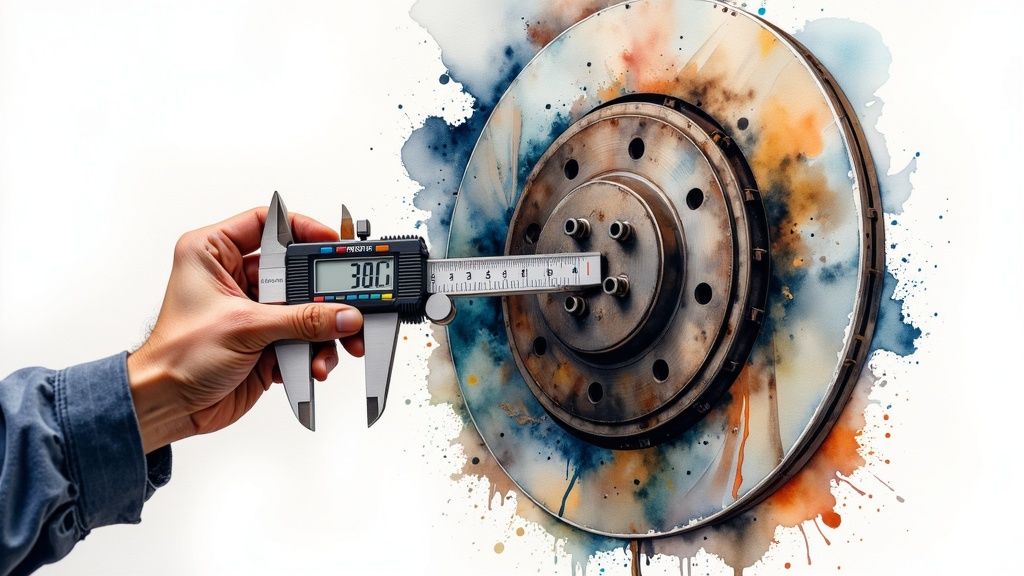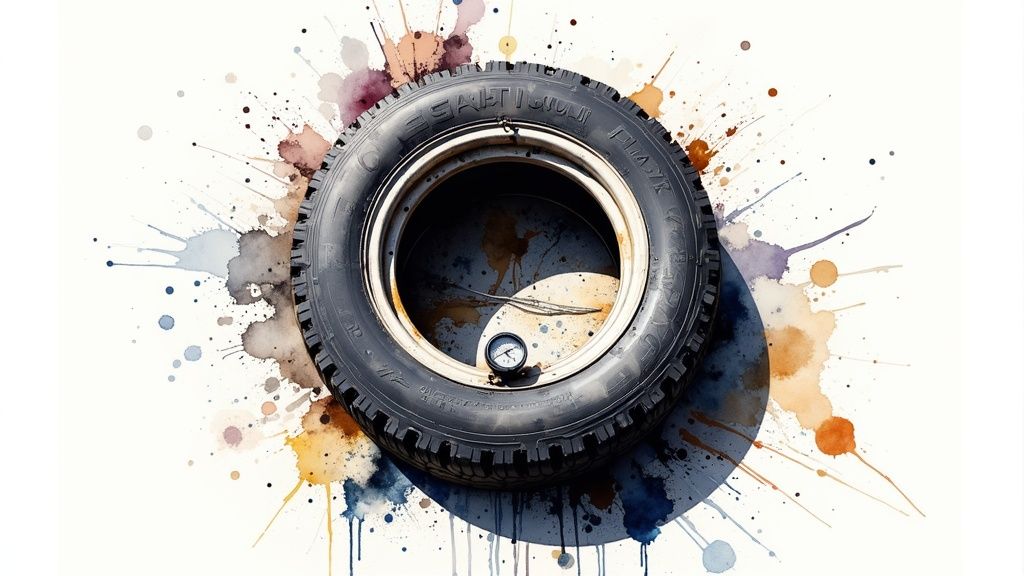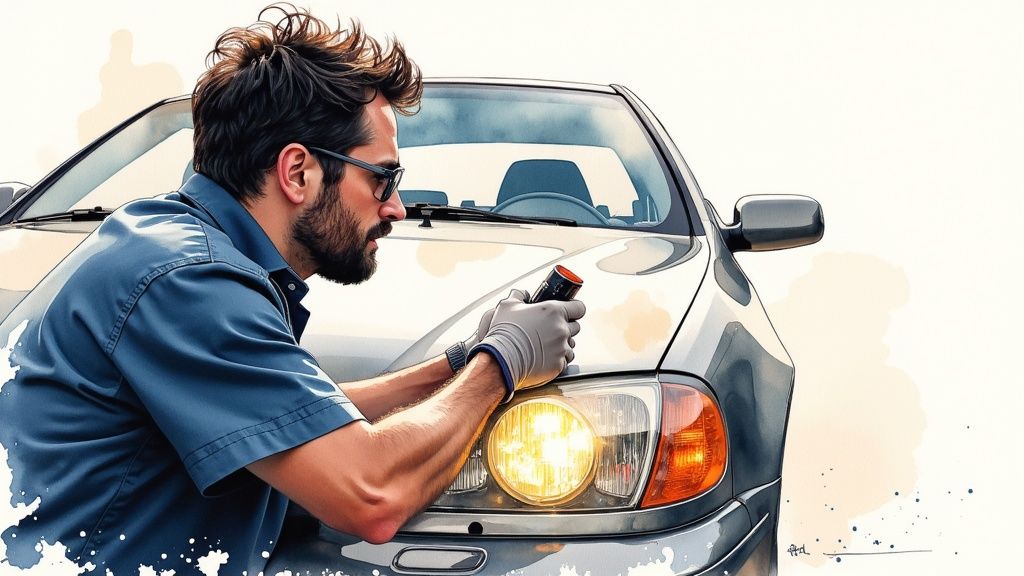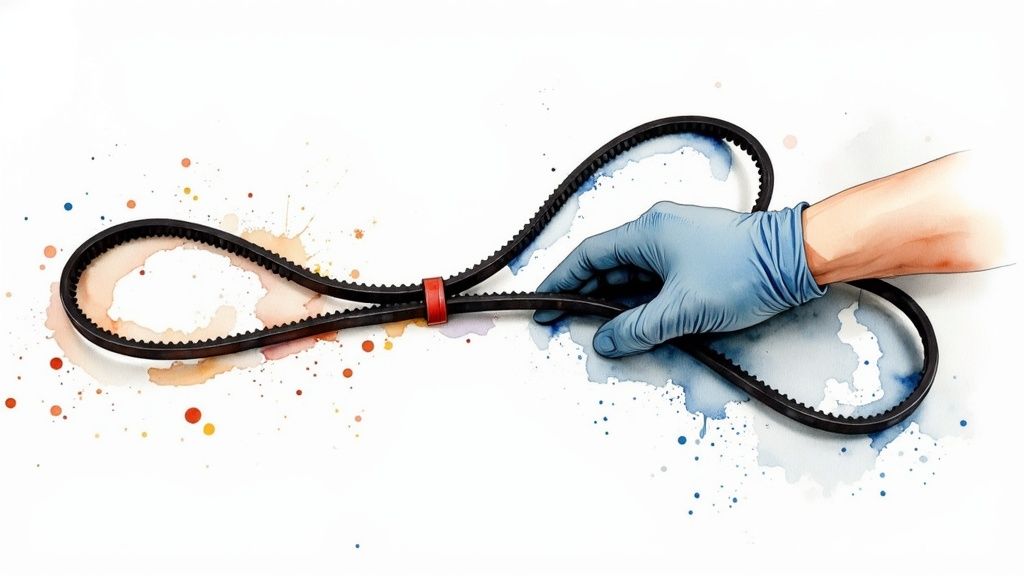
Kwik Kar Service Coupon
Get upto $20 OFF on all services.
This vehicle inspection checklist covers seven essential areas to keep your car running smoothly and safely. From brakes and tires to fluids and lights, this list empowers you to identify potential problems before they become major headaches. Regular checks can prevent breakdowns, extend your vehicle's life, and ensure your safety on the road. Whether you're a daily commuter, managing a fleet, or simply want peace of mind, this vehicle inspection checklist is your guide to proactive car maintenance.
A comprehensive brake system inspection is arguably the most critical aspect of any vehicle inspection checklist. It involves a thorough evaluation of all components responsible for slowing and stopping your vehicle, ensuring your safety and the safety of others on the road. This process goes beyond simply checking if your car stops; it delves into the condition of the entire system, identifying potential problems before they escalate into costly repairs or dangerous driving situations. This is especially crucial for those in Richardson relying on their vehicles daily, including commuters, families, and those in demanding professions like military personnel, first responders, and healthcare workers.

A thorough brake system inspection includes several key checks:
Pros:
Cons:
Examples:
Tips for Vehicle Owners:
Including a brake system inspection in your vehicle inspection checklist is essential for maintaining safety and preventing costly repairs down the line. For Richardson residents, especially those with older vehicles or high mileage, a comprehensive brake inspection is an investment in peace of mind. This is particularly true for families and those in time-sensitive professions who need their vehicles to be reliable and safe. Whether you're managing a small business fleet or simply ensuring the safety of your family vehicle, regular brake inspections should be a priority.
A crucial part of any vehicle inspection checklist is a thorough assessment of tire condition and pressure. This involves much more than just a quick glance. Tires are the only contact points between your vehicle and the road, making their condition paramount for safe handling, braking, and overall vehicle operation. A comprehensive tire inspection ensures optimal performance, fuel efficiency, and most importantly, your safety on the road. This is especially critical for local Richardson commuters, families, and those who rely on their vehicles daily, such as military personnel, first responders, and healthcare workers.

A proper tire inspection includes several key features: measuring tread depth with a dedicated gauge (not just the penny test!), checking for even or uneven wear patterns (which can indicate alignment or suspension issues), inspecting sidewalls for bulges, cuts, or cracks, and verifying the correct inflation pressure in all tires, including the often-forgotten spare. Even the valve stems should be examined for damage and the tire's age determined via the DOT code. Learn more about Tire Condition and Pressure Inspection This level of detail is particularly important for owners of aging or high-mileage vehicles and small business fleet managers in Richardson looking for comprehensive preventative maintenance.
Pros of regular tire inspection:
Cons to consider:
Examples of Tire Inspection Services:
Actionable Tips for Effective Tire Inspections:
Major tire manufacturers like Michelin, Goodyear, Bridgestone, and online retailers like Tire Rack have long championed the importance of regular tire inspections and maintenance. By including this crucial step in your vehicle inspection checklist, you are prioritizing safety, performance, and the longevity of your vehicle.
A crucial part of any vehicle inspection checklist is the Fluid Levels and Condition Check. This systematic examination of all essential vehicle fluids plays a vital role in maintaining your vehicle's operation, performance, and longevity. It involves checking the levels and condition of engine oil, coolant, transmission fluid, power steering fluid, brake fluid, and windshield washer fluid. This check helps prevent potential damage, ensures optimal performance, and can even reveal underlying mechanical problems before they escalate into major failures, making it an indispensable part of any comprehensive vehicle inspection.

This process involves several key features: checking the engine oil level and condition using the dipstick; examining the coolant level in the reservoir and radiator (when safe and cool); inspecting the transmission fluid level and color; assessing the power steering fluid level and condition; verifying the brake fluid level in the master cylinder; and confirming an adequate windshield washer fluid level. For Richardson commuters, families, military personnel, first responders, healthcare workers, owners of older vehicles, and small business fleet managers, this check provides critical insights into the health of their vehicles.
Pros:
Cons:
Examples of Successful Implementation:
Tips for Effective Fluid Checks:
Why This Item Deserves its Place in the Vehicle Inspection Checklist:
The Fluid Levels and Condition Check is a fundamental aspect of vehicle maintenance, directly impacting reliability, performance, and longevity. Its simplicity, accessibility, and potential to prevent significant problems make it a cornerstone of any effective vehicle inspection checklist, especially for those in Richardson seeking to keep their vehicles in optimal condition. Regular fluid checks, along with other preventative maintenance measures, can save you money and hassle in the long run.
A critical part of any vehicle inspection checklist is the lighting and electrical system inspection. This comprehensive assessment ensures all vehicle lighting and electrical components function correctly for optimal visibility, proper signaling, and compliance with safety regulations. This process covers everything from headlights and taillights to the battery's condition and the charging system's output. A thorough electrical system inspection is essential for maintaining a safe and reliable vehicle, contributing significantly to a comprehensive vehicle inspection checklist.

This inspection involves testing the functionality of all exterior lights, including headlights, tail lights, turn signals, brake lights, and reverse lights. It also includes checking headlight aim and brightness, inspecting the battery terminals and cables for corrosion and damage, and testing the charging system output (alternator) to ensure it's adequately powering the vehicle's electrical systems. Furthermore, the inspection covers verifying horn operation, examining windshield wiper and washer function, and checking all dashboard warning lights and indicators. For individuals in Richardson, especially commuters, families, military personnel, first responders, healthcare workers, owners of older vehicles, and small business fleet managers, this aspect of a vehicle inspection is paramount for safety and reliability.
Features of a Lighting and Electrical System Inspection:
Pros:
Cons:
Examples of Implementation:
Organizations like AAA offer free vehicle light inspections, particularly during National Car Care Month in October. Auto service providers such as Pep Boys include electrical system testing as part of their complete vehicle inspections. State and provincial vehicle inspections also have strict lighting requirements, further emphasizing the importance of this check. Learn more about Lighting and Electrical System Inspection
Tips for Conducting a Lighting and Electrical System Inspection:
This part of the vehicle inspection checklist deserves its place due to its impact on safety and legal compliance. Properly functioning lights are crucial for safe night driving and ensuring other drivers can see your vehicle. A healthy electrical system is the backbone of modern vehicles, powering everything from essential safety features to comfort and convenience systems. Regularly inspecting these systems can prevent costly repairs down the road and ensure your vehicle operates safely and reliably.
A critical part of any thorough vehicle inspection checklist is the suspension and steering system check. This detailed inspection focuses on the components responsible for your vehicle's handling, ride comfort, and most importantly, directional control. These components include shocks, struts, springs, tie rods, ball joints, and the power steering system. A properly functioning suspension and steering system is crucial for both safety and optimal vehicle performance. Neglecting these components can lead to decreased control, uneven tire wear, and potentially dangerous driving situations. This is particularly important for local Richardson commuters, families, military personnel, first responders, healthcare workers, and small business fleet managers who rely on their vehicles for daily activities and require consistent performance and safety.
This check examines several key areas:
Including a suspension and steering system check in your vehicle inspection checklist offers several key benefits:
Pros:
Cons:
Successful implementation of this check is a standard practice in many reputable auto service centers. For example, Mercedes-Benz includes suspension checks at regular service intervals, Firestone Complete Auto Care provides free visual suspension inspections, and Midas offers a thorough suspension system check as part of their alignment service. Learn more about Suspension and Steering System Check
Actionable Tips for Drivers:
Companies like Monroe, Bilstein, Moog, and KYB, specializing in suspension and steering components, highlight the importance of regular checks. By incorporating these tips and including a suspension and steering system check in your vehicle inspection checklist, you contribute significantly to a safer and more enjoyable driving experience. This is particularly relevant for owners of aging or high-mileage vehicles who need regular diagnostics and tune-ups to maintain optimal performance and safety. Therefore, this check deserves a prominent place on any vehicle inspection checklist due to its direct impact on safety and handling.
A critical part of any vehicle inspection checklist is the exhaust system inspection. This thorough examination assesses the entire system, from the exhaust manifold to the tailpipe, ensuring it functions correctly and safely. A properly functioning exhaust system is crucial not only for passing emissions testing but also for optimal engine performance, fuel efficiency, and, most importantly, the safety of the vehicle's occupants. This is why it deserves a prominent place in any vehicle inspection checklist.
How it Works:
The exhaust system inspection involves a detailed evaluation of several key components:
Benefits of a Thorough Exhaust System Inspection:
Pros:
Cons:
Examples of Successful Implementation:
Several reputable auto service providers offer comprehensive exhaust system inspections:
Actionable Tips for Vehicle Owners:
When and Why to Use This Approach:
Exhaust system inspections should be part of your regular vehicle maintenance schedule. It's especially important to have your exhaust system inspected if you notice any unusual sounds, smells, or performance issues, or if your vehicle is due for an emissions test. For Richardson commuters, families, military personnel, first responders, healthcare workers, owners of aging vehicles, and fleet managers, routine exhaust system inspections are a crucial safety and maintenance measure. This proactive approach can save you money in the long run by identifying and addressing problems before they become major and costly repairs. Regular inspections also contribute to cleaner air and a healthier environment for everyone.
A crucial part of any vehicle inspection checklist is the belt and hose inspection. This systematic examination assesses the condition of all engine drive belts (like serpentine and timing belts) and fluid-carrying hoses (such as radiator, heater, power steering, and fuel hoses). This check is vital for preventing costly breakdowns and ensuring your vehicle operates reliably. Why does it deserve a place on this list? Because these components are critical for engine operation and their failure can lead to catastrophic damage. Neglecting this simple inspection can leave you stranded on the side of the road or facing expensive repairs.
This inspection involves a thorough examination of various components:
Benefits of a Thorough Belt and Hose Inspection:
Pros and Cons:
Examples of Successful Implementation:
Actionable Tips for Vehicle Owners:
This inspection is especially important for Richardson commuters who rely on their vehicles daily, families needing reliable transportation, military personnel and first responders needing peak vehicle performance, owners of aging or high-mileage vehicles, and small business fleet managers seeking to minimize downtime. By including a belt and hose inspection in your vehicle inspection checklist, you're taking a proactive step towards maintaining your vehicle's health, reliability, and longevity. Leading brands like Gates, Dayco, Continental, and Goodyear all recognize the importance of proper belt and hose maintenance.
| Inspection Item | Implementation Complexity 🔄 | Resource Requirements ⚡ | Expected Outcomes 📊 | Ideal Use Cases 💡 | Key Advantages ⭐ |
|---|---|---|---|---|---|
| Brake System Inspection | Moderate (wheel removal often needed; some specialized tools) | Medium (calipers, fluid testers, diagnostic for ABS) | Critical safety assurance; early issue detection | Routine safety checks; pre-trip inspections | Direct safety impact; prevents costly repairs |
| Tire Condition and Pressure Inspection | Low (simple tools like tread gauge and pressure meter) | Low (pressure gauge, tread depth tool) | Maintained traction, fuel efficiency, tire longevity | Monthly checks; alignment diagnostics | Simple, fast, extends tire life |
| Fluid Levels and Condition Check | Low to Moderate (some fluids require careful handling) | Low (dipsticks, visual inspection) | Prevents engine/component damage; early leak detection | Regular maintenance; pre-service checks | Early problem identification; no special tools needed |
| Lighting and Electrical System Inspection | Low to Moderate (mostly visual & basic testing) | Low to Medium (multimeter, helpers for brake lights) | Ensures legal compliance, night driving safety | Legal inspections; safety checks before night driving | Simple fixes; essential for legal operation |
| Suspension and Steering System Check | High (vehicle lift often needed; specialized tools) | Medium to High (inspection tools, diagnostic devices) | Improved handling and safety; prevents uneven wear | Handling complaints; after impact or rough roads | Critical for vehicle stability and safety |
| Exhaust System Inspection | Moderate to High (vehicle lift needed) | Medium (visual and auditory checks) | Emissions compliance; prevents hazards; fuel efficiency | Emissions testing; safety inspections | Prevents CO poisoning; maintains engine performance |
| Belt and Hose Inspection | Moderate (some components hard to access) | Low to Medium (visual inspection tools) | Prevents breakdowns; extends engine reliability | Regular maintenance intervals | Cost-effective preventive measure |
This vehicle inspection checklist, encompassing everything from brake system and tire inspections to fluid checks and exhaust system reviews, provides a solid foundation for maintaining your vehicle's health and safety. Regularly performing these checks can help you identify potential problems early, preventing costly repairs and ensuring a safer driving experience. Remember, catching issues early, like worn brake pads or low tire pressure, can significantly extend the life of your vehicle's components.
Regular vehicle inspections are crucial for safety, but they're just one part of maintaining your car's health. For a comprehensive guide to car maintenance based on mileage, check out this helpful resource: car maintenance schedule. Understanding your car's maintenance needs based on its mileage helps prevent bigger problems down the road and ensures you're performing all the recommended services.
Mastering the concepts behind this vehicle inspection checklist empowers you to take control of your car’s well-being, whether you're a Richardson commuter, a family focused on safety, a member of the military or a first responder taking advantage of service discounts, or managing a fleet of vehicles for your small business. A proactive approach to maintenance provides peace of mind, knowing your vehicle is reliable and safe on the road.
For professional assistance with your vehicle inspection checklist and comprehensive car care, trust the experts at Kwik Kar Oil Change and Auto Care. We offer thorough inspections and maintenance services by ASE-certified technicians, utilizing state-of-the-art equipment to ensure your vehicle receives the best possible care. Schedule your appointment with Kwik Kar Oil Change and Auto Care today and experience the Kwik Kar difference!
CLICK LINK BELOW TO LEARN MORE ABOUT OUR SERVICES

Get upto $20 OFF on all services.